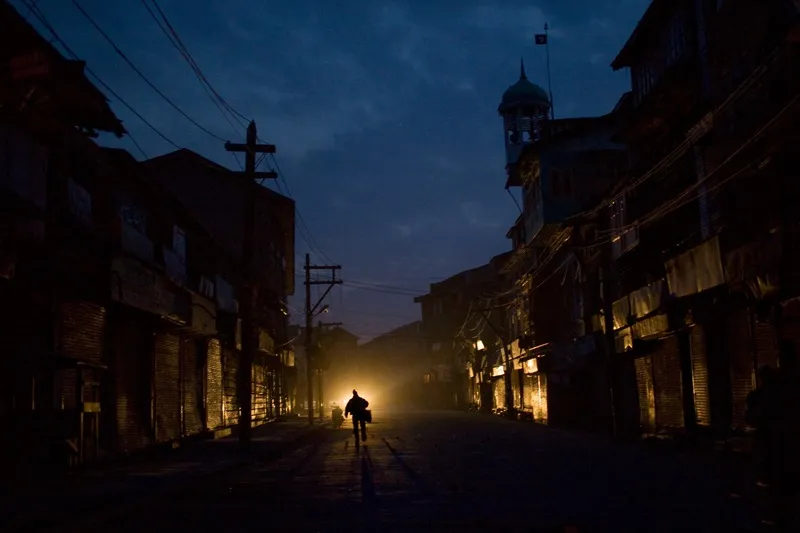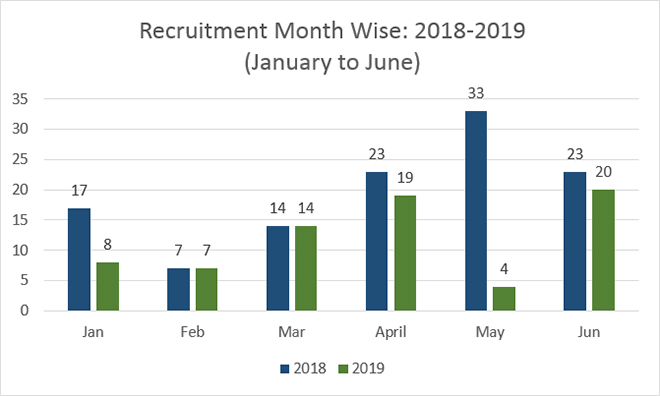-
CENTRES
Progammes & Centres
Location
Although statistics and the mood on the ground do reflect considerable progress, bringing normalcy back to the Valley remains an elusive goal.

Militancy in Jammu and Kashmir is showing signs of decline for the first time since 2013. Even though the government of India kept making tall claims about the effectiveness of its Kashmir policy in the last term, the situation on the ground deteriorated sharply following the Burhan Wani encounter. It is only in the last few months that the first signs of an ebb in militancy have become palpable. This is in large part due to the measures taken in the aftermath of the Pulwama suicide attack, and the tactical shift in Pakistan’s approach to Kashmir after the Balakot airstrike.
As per the government statistics, the recruitment of the locals by militant groups has come down by 40%. Cross border infiltration has waned by 43%, compared to last year. For the past few years, top ministers used the figures of militants eliminated by the security forces as a measure of the success, even though the ranks of militant groups kept swelling. Not only was recruitment of locals by militant groups high, the infiltration by Pakistani terrorists ensured that the number of militants didn’t reduce despite the number of security operations to eliminate them.
But if the government’s assertion — the 40% decline in local recruitment — is correct, then it is the first significant sign of a turning tide. Since 2013 onwards the local recruitments has risen exponentially: From a low of 16 in 2013 it kept going up steadily till the killing of Burhan Wani, after which the flood gates opened. In 2016, the number was 88 and went up to 126 in 2017 and was almost 200 in 2018. If the trend witnessed in the first six months of 2019 continues, the net recruitment for this year, which has kept increasing for each year since 2013, will be lower than the previous.
Similarly, the cross border infiltrations kept increasing in the last three years. As per the data released by the Union Home Ministry, there were 119 cases of infiltrations in 2016, 136 in 2017 and 143 in the year 2018. Recently the Minister of State for Home Affairs claimed in the parliament that the net infiltration in the first six months of 2019 has reduced by 43% as compared to the corresponding period in 2018.
For the last three years, the government kept citing the figures of “record number of terrorists eliminated” ad nauseam to prove the success of its security approach in Kashmir, this despite the fact that that the attrition rate did not decline. Thus the situation on ground kept slipping into more chaos. Clearly, the metrics earlier used by the government to determine the success were flawed. Only the decline in recruitments, infiltrations and the attacks initiated by the militants can reflect an improvement of the law and order situation.
 Source: ORF Kashmir Conflict Tracker
Source: ORF Kashmir Conflict Tracker Credit: Khalid Shah
Credit: Khalid ShahSignificantly, the government claims stone-pelting and terror incidents are also coming down. Trends emerging from the numbers are also corroborated by the anecdotal accounts of the lull being witnessed on the ground. There is a considerable change in the discourse of the separatist groups too. The so-called moderate faction of the Hurriyat has called for a dialogue, and there is a notable change in the position of the Mirwaiz Umar Farooq who is now issuing statements on societal issues like education, drug addiction, women’s rights et al. Apart from that, there seems to be a growing indifference towards the death of militants in the Valley. In the last few months, Kashmir has shut down on only rare occasions in protest against the killing of militants.
On social media, the phenomenon of viral pictures, audios and videos is also on a downward trajectory particularly after the killing of 12-year-old Aatif, who was held hostage by the LeT terrorists. The recent clash between ISIS/Al Qaeda inspired groups and the pro-Pakistan groups have dealt a severe blow to the propaganda of the militants. The local population is wary of such clashes as they are reminiscent of the fratricide clashes of the past, which claimed hundreds of lives.
On the external front, it appears the Pakistan army is pushing lesser numbers of terrorists across the border. The Balakot airstrike put a great deal of international pressure on Pakistan to curb cross border terrorism and thus the tactical shift of its army is not surprising. The terrorists already operating in J&K may have also been asked to temper down their activities including the recruitment.
Although statistics and the mood on the ground do reflect considerable progress, bringing normalcy back to the Valley remains an elusive goal. This despite the fact that apprehensions of militancy gaining traction in the northern and the central parts of the Valley have been proved alarmist, at least for now.
Unfortunately the operational procedures adopted by the security forces belie government claims that the problem of militancy has been controlled and contained to the four districts of South Kashmir. The collective punishment meted out to a large section of the population by imposing curbs on the movement on the highway reeks of insensitivity and lack of nuance in the implementation of the policies — most importantly the sense of insecurity and paranoia regarding another major terror attack — remains.
It would be a gross error to confuse the fatigue and momentary period of a lull as permanent change. As has been witnessed in the past, the delicate balance of momentary calm takes a small trigger to ignite unrest, and it is therefore imperative that the government maintains a well thought out and sensitive approach towards the problem. For instance, the unrests of 2008 and 2010 did not last for more than a few months but in the long term both proved to have far damaging outcomes in the long run.
Recent assertions of the top functionaries of the government suggest that an abolishment of Article 370 and Article 35A might be on the anvil. It took Kashmir Valley three years to come out the wave of unrest of 2016. Instead of acting in a knee jerk manner and precipitating a new crisis, the government would be well advised to do everything possible to prolong the current lull period and ease out the some of the hard measures, at least in the parts of Kashmir which are not the strongholds of militants anymore.
Post Balakot scenario has for the umpteenth time proven that the root cause of the problem exists across the border. But the negative effects of how the past governments have handled the internal situation in J&K has always created a room for manipulation by Pakistan. At a time when the mood on the ground appears to be calming down, it will be unwise and counter-intuitive for the government to provide a trigger that could lead to another unrest.
The views expressed above belong to the author(s). ORF research and analyses now available on Telegram! Click here to access our curated content — blogs, longforms and interviews.

Khalid Shah was an Associate Fellow at ORF. His research focuses on Kashmir conflict Pakistan and terrorism.
Read More +